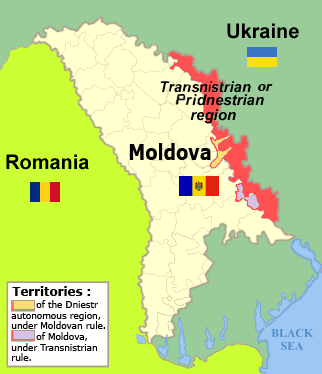Dubăsari
| Dubăsari | |
|---|---|
 Dubăsari Location within Transnistria | |
| Coordinates: 47°16′N 29°10′E / 47.267°N 29.167°ECoordinates: 47°16′N 29°10′E / 47.267°N 29.167°E | |
| Country |
|
| County | Transnistria |
| Population (2004) | |
| • Total | 28,500 |
| Time zone | EET (UTC+2) |
| • Summer (DST) | EEST (UTC+3) |
| Climate | Dfb |
| Website | http://www.dubossary.com/ |
Dubăsari (Romanian pronunciation: [dubəˈsarʲ]; Moldovan Cyrillic:Дубэсарь Russian: Дубоссары; Bulgarian: Дубъсари; Ukrainian: Дубоссари, sometimes Dubossary in English) is a city in Transnistria, with a population of 23,650. The city is under the administration of the breakaway government of the Pridnestrovian Moldavian Republic, and functions as the seat of the Dubăsari District, Moldova.
Name
The origin of the town name is the plural form of the Romanian archaic word dubăsar ("boatman"), a derivative of dubă ("a small wooden boat"), so "Dubăsari" means "boatmen".
History
Dubăsari is the site of one of the oldest settlements in Moldova, and the Transnistrian region. Stone age artifacts have been found in the area, and there are several kurgans (presumed Scythian) around the city. First mentions of modern Dubăsari date to the beginning of the 16th century, as a fair populated by Moldavian peasants. The settlement became part of the Russian Empire in 1792, and was granted city status in 1795. It was part of Kherson Governorate from 1803 to 1922.
In 1924-1940, Dubăsari was part of the Soviet-created Moldavian ASSR. The town was heavily industrialized during the pre-WWII period. In the course of World War II, in 1940, when Bessarabia was occupied by the Soviet Union, it became part of the newly created Moldavian SSR. On 27 July 1941, the town was occupied by German and Romanian troops. It was re-captured by Soviet forces in the summer of 1944.
In 1951-1954, the Dubăsari dam, and a 48 MW hydroelectric power plant Dubossarskaya GES was constructed, and Dubossary Reservoir was formed.
Dubăsari and its suburbs were the site of major conflict during 1990-1992, that eventually degenerated in the War of Transnistria (1992). Since then, it has been controlled by the breakaway administration of Transnistria.
The city's economy was significantly damaged during the war in 1992.
Population

In 1989, the population of the city was 35,806, including 15,414 Moldovans, 10,718 Ukrainians, 8,087 Russians, and 1,587 others. According to the 2004 Census in Transnistria, the city had 23,650 inhabitants,[1] including 8,954 Moldovans, 8,062 Ukrainians, 5,891 Russians, 153 Belarusians, 104 Bulgarians, 90 Armenians, 49 Poles, 66 Gagauzians, 46 Jews, 39 Germans, 31 Gypsies, and 165 others and non-declared.
Notable natives
- Vasile Iovv, Moldovan communist politician, adjunct of the prime minister of the Republic of Moldova[2]
- Vlad Grecu, a Moldovan writer
References
- ↑ pridnestrovie.net
- ↑ Vasile Iovv's biography on parlament.md
External links
- (Polish) Dubosary (Dubăsari) in the Geographical Dictionary of the Kingdom of Poland (1881)
- Site of city of Dubăsari
- Visit Dubossary (in English)
- Dubăsari (in Romanian)
| |||||||||||||||||||||||||
| ||||||||||
